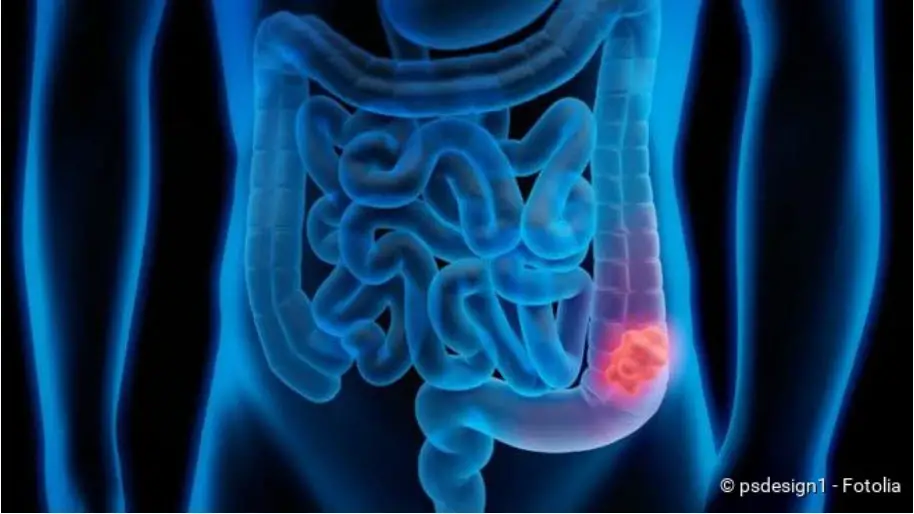Colon cancer: symptoms, warning signs, therapy, prognosis
Colon cancer: symptoms, warning signs, therapy, prognosis
Colon cancer (colorectal carcinoma) is a malignant tumor of the colon or rectum. It usually develops from benign intestinal polyps. So far, the only cure for colorectal cancer is surgery. Other methods such as chemo- or radiotherapy often support the treatment. Here you can read all the important information on the topic: How do you recognize colon cancer? What are its causes and risk factors? How is colorectal cancer treated? What are the chances of recovery?

Brief overview
- What is colon cancer? Malignant tumour in the large intestine (colon carcinoma) or rectum (rectal carcinoma). In summary, physicians speak of colorectal carcinoma in colorectal cancer.
- Frequency: Colorectal cancer is the second most common cancer in women and the third most common cancer in men. Every year, about 29,500 women and 33,500 men develop colorectal cancer. At the time of diagnosis, patients are on average 73 years (men) and 75 years (women) old.
- Symptoms: Colorectal cancer develops slowly, and usually remains without symptoms for a long time. Possible signs in the further course are changed stool habits (diarrhoea and/or constipation), blood in the stool, unwanted weight loss, anaemia, possibly abdominal pain, slight fever, fatigue, poor performance.
- Causes and risk factors: poor diet (low fibre, high in meat and fat), lack of exercise, overweight, alcohol, nicotine, genetic factors, chronic inflammatory bowel disease (especially ulcerative colitis), type 2 diabetes mellitus
- Treatment: Depends on several factors such as location, size and spread of the tumour. The most important therapeutic option is surgery. Further treatments can be initiated to support this, such as chemo- or radiotherapy.
- Prognosis: The earlier colon cancer is detected and treated, the better the chances of recovery. If daughter tumours (metastases) have already formed in other parts of the body, the prognosis deteriorates.
Colorectal cancer: symptoms
Colon cancer usually goes unnoticed for a long time. Complaints only occur when the tumour has reached a certain size. Then it can interfere with the passage of the food residues. As a result, the bowel movement changes (constipation, diarrhoea). Often there is also blood in the stool.
Like any cancer, the tumor also weakens the entire body. Therefore, unspecific complaints such as poor performance, unintentional weight loss and possibly a slight fever can also occur. If the tumour has already spread to other organs in an advanced stage (metastases), further symptoms may occur.
In the following, you can read more about how to recognize colorectal cancer. But be careful: The above-mentioned complaints are not a clear sign of colorectal cancer, but can also have other causes. But you should always have a doctor check them out. This is especially true when relatively young people experience potential colorectal cancer symptoms. Colon cancer is extremely rare in younger people.
Colorectal cancer symptoms: Altered bowel movement
Many patients alternately suffer from constipation and diarrhoea because the tumour narrows the intestine: the stool initially accumulates in front of the tumour. It is then liquefied by bacterial decomposition and excreted as sometimes malodorous diarrhoea. This alternation of constipation (constipation) and diarrhoea (diarrhoea) is also known as paradoxical diarrhoea. It is a classic warning sign for colon cancer.
Some patients even suffer from repeated constipation or repeated diarrhoea.
If additional unintentional stool is excreted when winds blow, this can also be an indication of intestinal cancer. Doctors speak of the phenomenon of the “false friend”. It occurs when the muscle tension of the anal sphincter is reduced. The reason for this can be deep-seated intestinal cancer that travels through the muscle and thus disturbs its function.
In people over 40 years of age, any change in stool habits that lasts longer than three weeks should generally be clarified by a doctor.
Colon cancer symptoms: Blood in the stool
A malignant tumour is not as stable as healthy tissue. That’s why he bleeds a lot. In colorectal cancer, this blood is excreted together with the stool. For example, the majority of colon cancer patients have blood in their stool.
These blood admixtures are sometimes visible to the naked eye. The color gives an indication of the location of the tumor: If the colon cancer is located in the rectum, the blood in the stool appears red (fresh blood). In other cases, the stool is pitch-black discolored by older (dark) blood. This so-called tarry stools indicates a bleeding in the upper digestive tract (stomach, duodenum). However, it cannot be ruled out that tarry stools may also occur if there is a source of bleeding in the colon.
Much can be achieved through diet. It should be high in fibre, with plenty of fruit and vegetables. In addition, you should only eat a small amount of dark red meat and smoked goods. Also helpful: reduce alcohol, do not smoke, exercise regularly, lose weight. And: Take advantage of the possibilities for screening for colon cancer, especially colonoscopy – the so-called preventive colonoscopy.
Preventive colonoscopy is recommended from the age of 55 onwards at intervals of then always ten years. In case of complaints, hereditary risk or if polyps have been removed, however, the mirroring should definitely be performed at shorter intervals. A stool test for occult (non-visible) blood is carried out during the annual check-up from the age of 50. But this test is unsafe! Even if no blood is found, a colonoscopy should follow in case of doubt.
Colonoscopy is now a routine examination. Somewhat unpleasant is the preparation for cleaning the intestine, which must be completely emptied. But this is absolutely necessary so that we do not overlook anything. The actual colonoscopy is then usually performed in twilight sleep, so that the patient is not aware of it. Since helium gas is used to unfold the intestine, there is no more massive flatulence after the examination.
However, many colon cancer patients excrete so little blood that it is not noticeable in the stool. These “invisible” blood admixtures are also called occult blood. It can be detected with certain tests (e.g. hemoccult test).
Despite its frequency, blood in stool is not a specific sign of colon cancer. There may also be other causes behind this. Most often, blood residues on the stool or toilet paper are due to haemorrhoids. Typically, the blood then tends to be light red in colour and deposited on the stool. The blood in colorectal cancer, on the other hand, is usually mixed with the stool due to intestinal movements.
In addition to haemorrhoids, bleeding sources in the oesophagus, stomach or duodenum are also possible causes of blood in stool (for example, a stomach ulcer).
General colorectal cancer symptoms
Colorectal cancer can also cause a person’s general condition to deteriorate. For example, those affected feel unusually tired and weak and are not as efficient as usual. Fever can also be a sign of colon cancer.
Anemia can occur especially in the advanced stage of the disease. It develops because the malignant intestinal tumour often bleeds. Iron is lost with the blood. However, since iron is necessary for the formation of the red blood pigment (haemoglobin), anaemia results from iron deficiency (iron deficiency anaemia). It manifests itself with symptoms such as paleness, poor performance, fatigue and in severe cases also with shortness of breath.
Another sign of colon cancer in advanced stages is unintentional weight loss. Doctors refer to this as tumor cachexia: due to the cancer, the body breaks down a lot of fat and muscle mass. Patients thus appear increasingly emaciated.
Other signs of colorectal cancer
If the colorectal cancer has spread to other parts of the body (metastasis), further symptoms may occur. It often forms daughter tumours in the liver (liver metastases). This can cause pain in the right upper abdomen, jaundice or elevated liver values in the blood, for example. Lung metastases are also not uncommon in colorectal cancer. They can make themselves felt by breathing difficulties or coughing.
However, colon cancer can also continue to grow in the intestine. It can damage the intestinal wall or surrounding tissue. A large tumour, for example, can constrict the intestine in such a way that the food residues can no longer pass the site. This leads to intestinal obstruction (ileus) – a serious complication of colorectal cancer.
Most often, colon cancer develops in the large intestine, which withdraws water and salts from the food pulp on its way to the anus.
Pain can also occur with colon cancer, for example cramp-like abdominal pain. Some patients also have pain when defecating.
In some cases patients report strong bowel sounds and flatulence. Both can of course also occur in healthy people. However, when such complaints accumulate, they are sometimes signs of intestinal cancer.
If it continues to grow, the tumour can break through the intestinal wall and cause peritonitis. If the cancer cells in the peritoneal cavity spread to the peritoneum, physicians refer to it as peritoneal carcinomatosis.
Colorectal cancer: rectal carcinoma
Rectal carcinoma (cancer of the rectum or rectal cancer) usually develops from cells of the mucus glands in the wall of the rectum (rectum). Then one speaks – in terms of the fine tissue – of a so-called adenocarcinoma.
Rarely, rectal cancer develops from other cell types. For example, when supporting tissue cells degenerate and become cancer cells, sarcoma develops. In contrast, a neuroendocrine tumor develops from so-called neuroendocrine cells. These come from the nervous system and release hormones or other messenger substances.
The rectal carcinoma is usually removed surgically. Depending on the stage of the tumour, patients also receive radiotherapy and/or chemotherapy.
You can read more about this form of colon cancer in the article Rectal cancer.
Colorectal cancer: causes and risk factors
Colon cancer develops in most cases from benign growths of the intestinal mucosa. In many people these so-called intestinal polyps remain harmless. In others, however, they continue to develop into colon cancer.
Intestinal polyps usually develop from cells of the mucous membrane glands in the intestinal wall. They are therefore considered to be adenomas. Colon cancer that develops from such benign adenomas is therefore classified as adenocarcinoma (carcinoma = cancerous growth). More rarely, intestinal polyps develop and thus cancerous tumours from other cell types.
The development from normal intestinal mucosa to polyp formation to the development of intestinal cancer is slow – it takes years. According to current knowledge, it is triggered by various risk factors. For example, certain dietary and lifestyle habits as well as hereditary factors are among the possible causes of colon cancer.
Intestinal polyps as a risk factor for intestinal cancer. Colorectal cancer very often develops from benign growths of the intestinal mucosa – the so-called intestinal polyps.
Nutrition and lifestyle
A low-fibre, high-fat and meat-rich diet (especially a lot of red meat and processed sausages) increases the risk of colon cancer. Such food passes through the intestines more slowly than vegetable, fibre-rich food. Experts suspect that carcinogenic substances in food remain in contact with the intestinal mucosa for longer and can damage it.
Lack of exercise and overweight also favour the development of intestinal cancer. Alcohol and nicotine also increase the risk of colorectal cancer (and other cancers).
Genetic factors
In some cases colorectal cancer is hereditary. It can be observed that first-degree relatives (parents, children, siblings) of colon cancer patients are more likely to develop this type of cancer themselves than other people.
On the one hand, there are genetic predispositions that do not directly increase the risk of colorectal cancer, but make the person affected more sensitive to colorectal cancer risk factors (such as a meat-rich diet). So here, the combination of hereditary factors and lifestyle is the trigger for the development of colorectal cancer.
On the other hand, there are gene changes (mutations) that directly promote the formation of a malignant tumour in the intestine. Some hereditary diseases are now known to increase the risk of colon cancer. Two examples:
- HNPCC (Hereditary Non-Polyposis Colon Cancer Syndrome or Lynch’s Syndrome): This is the most common form of hereditary colorectal cancer. Due to mutations, various repair systems for the genetic material are defective. This significantly increases the risk of colon cancer and other cancers (such as cancer of the uterus, ovaries and stomach).
- FAP (familial adenomatous polyposis, FAP): In this rare disease, countless polyps are formed throughout the intestine. They are very likely to develop into colorectal cancer over the years. Therefore, people affected must be regularly examined for colon cancer from childhood on. As a precautionary measure, bowel segments are often surgically removed to prevent bowel cancer in FAP.
Other risk factors for colorectal cancer
Age also has an important influence: the older someone is, the higher their risk of colon cancer. 90 percent of all colon carcinomas occur after the age of 50. However, the rarer genetically determined colorectal cancer often occurs at a young age. For example, typical gene alterations can usually be found in people suffering from colorectal cancer at the age of 30.
The risk of colon cancer is also increased if someone suffers from chronic inflammatory bowel disease. People with ulcerative colitis are particularly affected: in these people, the colon is chronically inflamed. The more extensive the inflammation and the longer the duration of the disease, the higher the risk of colon cancer. Crohn’s disease can also increase the risk of colon cancer. This is especially true if the chronic inflammation affects the large intestine (but is usually limited to the last section of the small intestine).
People with type 2 diabetes (diabetes mellitus type 2) have elevated insulin levels in the blood in the early stages of the disease. According to physicians, these are responsible for the fact that the risk of colorectal cancer is approximately three times higher. Insulin generally promotes the growth and reproduction of cells – including cancer cells.
Protective factors against colorectal cancer
In addition to the above-mentioned risk factors for colorectal cancer, there are also factors that protect against colorectal cancer. This includes regular physical activity and a diet rich in fibre and low in meat. The movement and the dietary fibres stimulate the intestinal movements. The food residues are thus transported faster through the intestines. This means that toxins in the stool can act on the intestinal mucosa for less time – the risk of intestinal cancer is reduced.
Colon cancer: examinations and diagnosis
If you suspect intestinal cancer, you should first consult your family doctor. If a colonoscopy is useful, he will refer you to a specialist in gastroenterology.
The doctor will first talk to you in detail to take your medical history (anamnesis). He’s having your symptoms described to him. He also collects information that will help him to better assess the likelihood of developing colorectal cancer in you. Possible questions of the doctor in the anamnesis interview are:
- Has your digestion changed (e.g. constipation or diarrhoea)?
- Did you notice blood in the stool?
- Does your family already have colon cancer?
- Does anyone in your family suffer or has suffered from other cancers such as breast, ovarian or cervical cancer?
- Have you lost weight unintentionally?
- Do you smoke and drink alcohol? How often do you eat meat?
- Are you familiar with diabetes?
Physical examination
Next the doctor will examine you physically. Among other things, he will listen to your stomach with the stethoscope and palpate it with his hands. In the case of colon cancer, the palpation can sometimes be painful.
A particularly important examination for suspected colorectal cancer is the so-called digital-rectal examination (DRU). The doctor palpates the rectum with his finger. It is not unusual for colon cancer to develop in this section.
Test for blood in stool
A stool sample is often used to check whether blood is added to the stool that is not visible to the naked eye (occult blood).
Immunological stool test
For some time now, doctors have been using the so-called immunological stool test, which reacts very sensitively to blood in the stool. He can distinguish between human and animal blood (when eating raw meat) in the stool. This is done with the help of antibodies that only bind to human blood.
However, this test says nothing about the source of human blood in the stool. For example, it can also be positive for nosebleeds, bleeding gums or haemorrhoidal bleeding.
Conversely, not all intestinal tumours bleed – or at least not permanently. Even if the test is negative, cancerous tumours may still be present in the intestine (false negative result). A colonoscopy is therefore always the safer alternative.
Hemoccult test
In the meantime, the so-called hemoccult test used in the past has been largely replaced by the immunological stool test. The hemoccult test is also sensitive to animal blood and some vegetables. Patients who, for example, had eaten raw meat prior to sampling, thus received a false positive result. False-negative results are possible if the patient has consumed a lot of vitamin C or if the cancerous tumor in the intestine is not (currently) bleeding.
Whether immunological stool test or hemoccult test: If intestinal cancer is suspected, an additional colonoscopy is performed.
Colonoscopy (colonoscopy)
It is the most meaningful examination for suspected colorectal cancer. The intestine is examined with a tube-shaped instrument (endoscope) equipped with a small camera and a light source. The interior of the intestine can thus be illuminated and viewed on a monitor.
During colonoscopy, the doctor may also remove intestinal polyps with a sling. It is also possible to take tissue samples (biospies) from suspicious areas of the intestinal mucosa. The tissue samples are examined in the laboratory for fine tissue (histological). In this way intestinal cancer can be reliably detected or ruled out.
In preparation for the examination, the doctor gives the patient a laxative. Only when the bowel has been emptied can it be easily examined during colonoscopy.
Alternatives to colonoscopy
If a normal colonoscopy is not feasible for any reason, the physician can resort to a virtual colonoscopy or a rectoscopy/sigmoidoscopy.
In virtual colonoscopy, a computer tomography (CT) is performed. From their images, a computer can calculate a three-dimensional image of the intestine and display it graphically. In order for the intestinal wall to be assessed reliably, the patient must first empty his or her intestine completely with laxatives (as in a normal colonoscopy).
A disadvantage of virtual colonoscopy is that it does not provide such precise results as normal colonoscopy. Furthermore, polyps cannot be removed or tissue samples taken during the examination. This means that a proper colonoscopy or surgical intervention may be necessary after all.
Rectoscopy is the reflection of the rectum with an endoscope. In sigmoidoscopy, not only the rectum is examined but also the section of the intestine in front of it (S-shaped loop of colon) using an endoscope. In contrast to normal colonoscopy, not the entire colon is examined here. The result of the investigation is therefore limited.
Further examinations for colorectal cancer
Once a diagnosis of colorectal cancer has been made, further examinations must show how far the cancer has progressed (colorectal cancer stages: see below):
- Rectal ultrasound examination (sonography): This allows us to determine how far the tumour has already spread in the intestinal wall.
- Ultrasound examination (sonography) of the abdomen: The ultrasound is used to search for metastases, especially in the liver. Other abdominal organs (spleen, kidneys, pancreas) are also examined.
- Computed tomography (CT): Here, too, one looks for colon cancer metastases, for example in the lungs or liver. The so-called CT angiography is also helpful: Using contrast agents and CT, the blood vessels can be depicted and evaluated very precisely.
- Magnetic resonance imaging (MRI): Just like CT, MRI allows very precise imaging of various tissues and organs. In this way, metastases can be detected and the exact location and spread of the tumour can be determined (important for the operation). The advantage of MRI is that, unlike CT, it does not use X-rays.
- Chest X-ray: A chest X-ray helps to detect metastases in the lungs.
In addition, the doctor regularly measures so-called tumor markers in the blood of colorectal cancer patients. Tumour markers are substances that are increasingly produced by tumours and released into the blood. In the case of colorectal cancer, for example, the “carcinoembryonic antigen” (CEA) in the blood may be elevated. However, it is not suitable for the early detection of colorectal cancer (healthy intestinal cells also produce CEA). Instead, the CEA level helps to assess the course of the disease and the success of therapy:
After surgical removal of the tumour, the CEA values fall into the normal range. If there is a relapse (recurrence), the value rises again. By determining the CEA value regularly, a relapse can be detected early on.
If hereditary colorectal cancer (HNPCC, FAP and other rare forms) is suspected, a genetic consultation and examination is carried out. The patient’s genetic material is examined for characteristic genetic changes (mutations). If the genetic test does indeed diagnose hereditary colorectal cancer, the doctor may also be able to offer genetic counselling and a genetic test to close relatives (parents, siblings, children). In this way it can be determined whether they also have a genetically increased risk of colon cancer. If so, regular preventive medical checkups with colonoscopy are useful.
Stages of colon cancer
Two systems are commonly used to classify the stages of colorectal cancer: First, there is the so-called TNM classification. It can be applied to almost all tumours and describes the spread of the tumour. Based on the TNM classification, the cancer can then be classified into specific colon cancer stages according to the UICC (Union internationale contre le cancer).
TNM Classification
TNM is an abbreviation for the following three terms:
- T for tumor: This parameter indicates the spread of the tumor. It is determined by the so-called infiltration depth (i.e. how deep the tumour has penetrated the tissue).
- N for nodes (lymph nodes): This parameter specifies whether and how many lymph nodes are affected by the cancer cells.
- M for metastases (daughter tumours): This factor indicates whether and how many metastases are present in more distant body regions.
For each of these three categories a numerical value is assigned. The more advanced the disease, the greater the numerical value. The TNM classification for colorectal cancer is
Tis
In situ carcinoma
Carcinoma in situ (CIS) is an early form of colon cancer. Colon cancer is still located in the uppermost layer of tissue (epithelium).
T1
Infestation of the submucosa
The tumour has spread to the thin layer of connective tissue (submucosa) below the intestinal mucosa.
T2
Infestation of the Muscularis propria
The tumour extends even further into the muscle layer below the submucosa.
T3
Infestation of the subserosa and pericolic or perirect fat tissue
The tumour has affected all wall layers of the intestine and extends to the outer layer of connective tissue (subserosa) or to the adjacent fatty tissue.
T4
Infiltration of the peritoneum (T4a) or other organs/structures (T4b)
The tumour has also affected the peritoneum or other organs.
N0
No lymph node infestation
N1
1-3 regional lymph nodes
Regional lymph nodes are the lymph node station near the tumor
N2a
4-6 regional lymph nodes
N2b
≥7 regional lymph nodes
M0
No remote metastases
M1a
Remote metastases: Only one organ affected
A so-called peritoneal carcinosis is a flat attack of the peritoneum with cancer cells.
M1b
Remote metastases: More than one organ affected or peritoneal carcinomatosis
Stages of colorectal cancer according to UICC
The colon cancer stages of the UICC (Union internationale contre le cancer) are based on the TNM classification. Depending on the extent of tumor infestation, colorectal cancer is assigned to a specific UICC stage in each patient. The treatment then depends on this. In addition, the UICC stage can be used to roughly estimate the patient’s prognosis.
Examples: A patient with an advanced tumor (T4) according to the TNM classification is still in UICC stage II as long as there are no metastases in lymph nodes or other organs (N0, MO). On the other hand, a patient with a proven distant metastasis (M1) is always in the most severe stage of colon cancer, stage IV.
Here is an overview of all UICC colorectal cancer stages:
UICC Stadium:
TNM Classification
Tis
I
to T2, if N0 and M0
II
T3 to T4, if N0 and M0
III
each T at N1 or N2 and M0
IV
each T and each N, if M1
Colon cancer: treatment
If colorectal cancer is detected in time, i.e. before it has formed daughter metastases in the body, it is often curable. The exact therapy of colorectal cancer initially depends on which part of the intestine is affected. For example, there are fundamental differences between the treatment of cancer of the colon (colon carcinoma) and rectum (rectal carcinoma). This section of the text explains the treatment of colon cancer (colon cancer). How rectal cancer is treated is explained in the text Rectal cancer.
The exact treatment plan for colon cancer depends on several factors in each individual case: For example, it plays a role where exactly the tumour is located, how large it is and whether it has already spread to other parts of the body (tumour stage). The age and general condition of the patient also influence the therapy planning.
Colon cancer: Operation
The most important treatment method for colorectal cancer is surgery: In this procedure, the affected part of the intestine is cut out with a safe distance (i.e. surrounding tissue). The surgeon then sutures the remaining intestinal ends together. Thus the patient has a continuous intestine again. Only very rarely does a colon cancer require the permanent or temporary creation of an artificial anus (anus praeter, stoma).
Together with the affected intestinal section, the adjacent lymph nodes are also removed. Both – intestinal section and lymph nodes – are closely examined in the laboratory. In the case of intestinal tissue, we check whether the tumour has been removed completely and into the healthy tissue. The lymph nodes removed are checked to see whether cancer cells have already spread there.
In early stages of the disease, surgery for colorectal cancer is usually sufficient as the only treatment: Colon cancer can be cured by cutting out the tumor completely. In more advanced stages, the tumour is also attempted to be removed as completely as possible. Daughter tumours such as liver metastases can also often be removed surgically. In individual cases, however, this depends strongly on the location and number of metastases. In addition, advanced colorectal cancer usually requires further treatment.
Chemotherapy for colon cancer
In the case of more advanced colon cancer (colon cancer), many patients receive chemotherapy in addition to surgery. In this case, there is a very high risk of a relapse (recurrence) despite complete removal of the tumour: Often, they have already distributed individual cancer cells in the body. Therefore chemotherapy is necessary:
The patient receives special cancer medication, so-called cytostatics. They inhibit the growth of cancer cells or damage them directly, causing them to die. The cytostatic drugs are administered at regular intervals either as infusions or in tablet form. The duration of therapy extends over about half a year.
Cytostatic drugs act on all fast-growing cells. These include not only cancer cells, but also many healthy cells, for example in the mucous membrane of the digestive tract and hair root cells. Possible side effects of chemotherapy therefore include nausea, vomiting, diarrhoea and hair loss.
Radiotherapy for colorectal cancer
Radiation therapy plays a role in colorectal cancer, especially if the tumor is located in the rectum (rectal carcinoma). In contrast, it is not standard for colorectal cancer (colon cancer). At best, it can only be useful to specifically combat metastases in the bone or brain.
Targeted drugs
In some cases, advanced colorectal cancer is also treated with targeted therapy: This involves administering drugs to the patient that are specifically targeted against specific features of the tumour. They are therefore only suitable for patients whose tumor has these characteristics. This can be determined by carefully examining a sample of the tumour in the laboratory.
One example of targeted drugs are so-called EGF receptor antibodies (such as cetuximab or panitumumab): In nine out of ten cases of colon cancer, docking sites (receptors) for the epidermal growth factor (EGF) are found on the surface of the tumour cells. It promotes the growth of cancer cells.
This can be prevented with EGF receptor antibodies: The drugs occupy the docking sites of EGF. The growth factor can then no longer dock – the tumour growth is slowed down.
Other targeted drugs that may be considered in certain cases of colorectal cancer are VEGF antibodies (such as bevacizumab): the abbreviation VEGF stands for “vascular endothelial growth factor”. This substance ensures that new blood vessels are formed (angiogenesis), which supply the tumour with nutrients and oxygen.
VEGF antibodies are so-called angiogenesis inhibitors: they inhibit the growth factor VEGF and thus the formation of new tumour-supplying blood vessels. This means that the cancer no longer receives enough blood to be able to spread further.
Colorectal cancer: course of disease and prognosis
The course of the disease and the prognosis of colorectal cancer depend crucially on the stage of the disease at which the tumor is discovered and treated. The quality of surgical care also plays a decisive role. The treatment is followed by careful aftercare. It serves to detect a possible relapse (recurrence) as early as possible.
Colon cancer: aftercare examinations
The attending physician will prepare an individual follow-up plan for each colorectal cancer patient: Over a period of five years, the patient should appear for follow-up examinations at certain intervals. These examinations include, for example, a doctor-patient consultation, a physical examination, the determination of the tumour marker CEA in the blood, a colonoscopy, ultrasound examinations of the abdominal cavity and a computer tomography of the abdomen and chest. The patient is informed by his doctor when which examination is due.
Colon cancer: chances of recovery
Whether colorectal cancer is curable depends crucially on the stage of the disease. If the tumour is discovered and treated early, it is easily curable. However, the chances of a cure for colorectal cancer decrease increasingly the further the tumor has progressed. In the case of extensive peritoneal carcinomatosis, the mean survival time of patients is even lower than in the case of other metastases (for example in the liver).
Colorectal cancer: life expectancy
Colorectal cancer life expectancy has increased in recent years. One reason for this is the precautionary programme that has been introduced: From a certain age, regular colorectal cancer screenings are planned. Thus, colorectal cancer can often be detected at an early stage. On the other hand, improved treatment options also contribute to an increased life expectancy in colorectal cancer patients.
In general, colorectal cancer life expectancy depends on the stage of the disease. It is usually stated with the so-called five-year survival rate. This is the proportion of patients who are still alive five years after diagnosis. A prerequisite for this is, of course, that treatment has taken place. For colorectal cancer (colon cancer) and rectal cancer (rectum cancer), the five-year survival rates are approximate.
UICC Stadium
Colon cancer
Rectal cancer
UICC Stage I
95 per cent
95 per cent
UICC Stage II
ninety percent
85 per cent
UICC Stage III
65 per cent
55 per cent
UICC Stage IV
5 per cent
5 per cent
Please bear in mind that these are statistical averages. The forecast in individual cases may deviate from these values, in some cases considerably.
Colorectal cancer: terminal stage
Unfortunately, people with the highest stage of colon cancer (stage IV) have a very poor prognosis with a five-year survival rate of only about five percent. In this situation a cure (curative therapy approach) is usually no longer possible. The patients then receive palliative treatment. Its main aim is to alleviate the patient’s symptoms and thus improve their quality of life. Sometimes, attempts are made to extend survival time by means of chemotherapy, but colorectal cancer patients must be aware that chemotherapy will not cure them. Life expectancy at this stage is about 12 months without treatment and up to 24 months with treatment (chemotherapy).
Colon Cancer Prevention
Colon cancer is often only detected when it is already advanced. But then the chances of recovery are not as good as in early stages of cancer. Therefore, preventive medical checkups are very important. This is especially true if someone has known risk factors for colorectal cancer such as obesity or bowel cancer in the family.
Within the framework of statutory colorectal cancer screening, health insurance companies pay for certain examinations at certain intervals for patients over 50 years of age. These include, for example, an examination of the stool for “hidden” (occult) blood and colonoscopy.
When you are legally entitled to such colorectal cancer screening tests, you can find out in the article Colon Cancer Screening).





